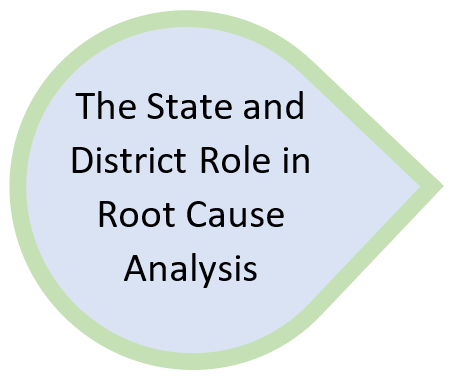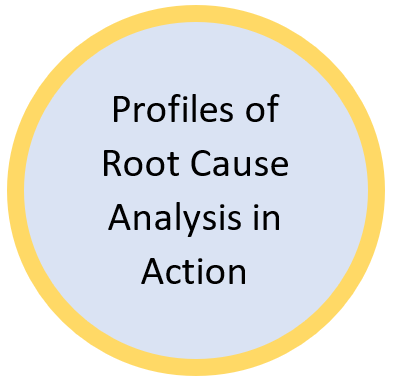Using Root Cause Analysis as Part of the Continuous Improvement Process in Education
A root cause analysis process is a systematic investigation of the contributing and foundational (or “root”) causes of the problems that organizations or institutions face. 1 In practice, root cause analysis is an approach to problem solving that uses data analysis and discussion to dig deeper than the surface symptoms of a problem to uncover the underlying causes. In recent years, identification of root causes has been highlighted as important for school improvement planning efforts.
This resource is designed to provide states and districts with information on root cause analysis as part of school improvement, including both high-level guidance as well as detailed examples of what root cause analysis can look like at the school level. This resource includes four main sections: the purposes of root cause analysis, different approaches to root cause analysis, the state and district role in supporting root cause analysis processes, and three detailed profiles of root cause analysis in Comprehensive Support and Improvement (CSI) schools (based on real-world examples).
To learn more about root cause analysis as part of school improvement planning, click on the graphic below, beginning with “Purposes of Root Cause Analysis”:




1 A root cause has been defined as a an issue that 1) has specific underlying causes, 2) can reasonably be identified, 3) under the control or sphere of influence of leaders, and 4) has potential recommendations for preventing recurrences of associated challenges (Rooney, James J.; Vanden Heuvel, Lee N. (2004). Root Cause Analysis for Beginners. ABSG Consulting Inc., Knoxville, TN). [Back]
Using Root Cause Analysis as Part of the Continuous Improvement Process in Education
- District Perspectives on Engaging Stakeholders in Financial Transparency
- Report Cards Community of Practice Summary
- Foster Care Community of Practice Summary
- Cultivating and Supporting Effective Rural School Leaders Community of Practice (CoP) Summary
- English Language Proficiency Community of Practice Summary
- National School Transportation Association Transportation Cost Analysis Tool
- Implementing Evidence-Based Practices Community of Practice (CoP) Summary
- ESSA Consolidated State Plan Development Community Summary
- Financial Transparency and Reporting Readiness Assessment Tool
- Webinar Series: Using Evidence to Strengthen Investments & Achieve Student Outcomes
- Using Evidence in State Education Agencies to Strengthen Education Investments and Achieve Student Outcomes
- Using Evidence as a Local Educational Agency - Webinar Two
- Using Evidence as a Local Educational Agency - Webinar One
- State Support Network Releases Technical Assistance Progress Report
- New Resources: English Learner Accountability and Evidence-Based Practices
- School Transportation Cost Analysis Tool Posted to Resource Library
- Competitive Grants for State Assessments Competition: Key Information and Dates
- Message from the Department of Education's Office of Special Education Programs
- SEA Staff: Let us Know Your Technical Assistance Needs
- State Support Network Launches Two Communities of Practice
- Terms of Use
- State Support Network: ESSA Implementation P2P Needs Sensing Activity
- State Support Network: ESSA Implementation Peer to Peer (P2P) Exchange Needs Sensing Activity
- Network Tools and Resources, by Topic
- Data Quality Component 1: Data Collection
- State and Local Educational Agency (LEA) Report Card Checklist
- Resources to Support EBP Step 2: Select Relevant EBPs
- Root Cause Analysis In Action
- Module 2A: State’s System of Annual Meaningful Differentiation (AMD)
- Module 2B, Section 2. Stakeholder Perceptions of Rationale for Combining Indicators
- Community Space Content Types
- Building State Capacity and Productivity Center Financial Transparency Resources
- CCSSO Federal Funding Streams Resources
- CCSSO Federal Funding Streams Resources
- Destination Known: Valuing College AND Career Readiness in State Accountability Systems
- Key Issues in Aggregating Indicators for Accountability Determinations under ESSA
- Leveraging the Every Student Succeeds Act to Support State Visions for College and Career Readiness
- Learning Cycle 1 - final agenda
- Pre Work Activity
- State and Local Report Card Resource Library
- Building Strategic Partnerships: State and District Collaboration Mapping Process
- New Community of Practice Resource Summaries
- New English Learners Guidebook
- Evaluating State Accountability Systems Under the ESEA
- State Support Network Releases Title III Modules
- Rural Problems of Practice Toolkit
- Differentiated Systems of Support for Rural Agencies Community of Practice Resources
- Reshaping rural schools in the Northwest Region: Lessons from federal School Improvement Grant implementation
- Evidence-Based Interventions: A Guide for States
- Assessment, Accountability, and Instructional Policies and Practices for Improving Outcomes for English Learner Peer-to-Peer Exchange Series Summary
- State Systems for Developing an Evidence Base Community of Practice
- School and District Improvement Peer-to-Peer (P2P) Exchange Series Summary
- Networked Improvement Implementation Community of Practice Resources
- School Mental Health Peer-to-Peer (P2P) Exchange Series Summary
- Equitable Services Peer-to-Peer (P2P) Exchange Series Summary
- Resource Allocation Reviews Community of Practice Summary
- Data for Improvement, Data for Accountability
- Reference List for Causes and Correlates of Chronic Absenteeism
- Evidence-Based Practices in School Improvement: Resource Links
- Foster Care Peer-to-Peer (P2P) Exchange Series Summary
- Principal Talent Management
- Designing Leadership Academies for Principal Professional Learning
- Root Cause Analysis Community of Practice Summary
- ESEA State Ombudsman Hub Summary
- ESEA State Ombudsman Community of Practice Summary
- Financial Transparency Community of Practice (CoP) Summary
- State Support for School Identification and Improvement Community of Practice Resources
- School Quality and Student Success (SQSS) Indicators Community Summary
- State Report Card Community of Practice (CoP) Summary
- Data Systems Community of Practice Resources
- Evidence-Based Practices Community of Practice Resources
- Implementing Needs Assessment Community of Practice Resources
- Scaling Needs Assessment Community of Practice Resources
- State policies for intervening in chronically low-performing schools: A 50-state scan
- Redesigning Teacher Evaluation: Lessons from a Pilot Implementation
- Pathways to New Accountability Through the Every Student Succeeds Act
- Implementing the Every Student Succeeds Act Toward a Coherent, Aligned Assessment System
- Making the Grade: A 50-State Analysis of School Accountability Systems
- Individualized Technical Assistance
- Network Tools and Resources, by Focus Area
- Data Quality Component 6: Stakeholder Connections and Communication
- Data Quality Component 5: Subgroup Analysis and Reporting
- Data Quality Component 4: Data Coherence
- Data Quality Component 3: Internal Data Control and Governance
- Data Quality Component 2: Data Quality
- State Support Network Releases Needs Assessment Guidebook
- Peer-to-Peer Exchanges
- Privacy Policy
- Selecting Evidence-Based Practices for Tiers 1, 2, and 3: Navigating Clearinghouses and Databases
- Topics of Peer to Peer Exchanges
- Resources to Support EBP Step 1: Identify Local Needs
- Resources to Support EBP Step 3: Plan for Implementation
- Resources to Support EBP Step 4: Implement
- Results First Clearinghouse Database Tiers
- School Improvement: Needs Assessment
- School Improvement: Strategy Selection
- School Improvement: Grant Fund Distribution
- ESSA Implementation Planning Tool
- Plans That Work: Tools for Supporting School Improvement Planning
- Needs Assessment Guidebook
- For Each and Every Child: A Strategy for Education Equity and Excellence
- State Educational Agency Sustainability Rubric
- Evidence-Based Practices Resource Synthesis
- Criteria for Procuring and Evaluating High-Quality Assessments
- Newly Completed Community of Practice Summaries
- School Improvement: Progress Monitoring
- Evaluating State Accountability Systems Under the ESEA
- Guidebook on State Approaches to Incorporating English Learners Into Title I Accountability Systems
- Using Root Cause Analysis as Part of the Continuous Improvement Process in Education
- Data Quality Community of Practice Summary
- Purposes of Root Cause Analysis in School Improvement Planning
- Approaches to Root Cause Analysis
- The State and District Role in Root Cause Analysis
- Alpha Elementary School
- School Profile B: Bravo Middle School
- School Profile C: Charlie High School
- Evaluating State Accountability Systems Under ESEA: Module 1: Theory of Action
- Section 1: Articulate the Theory of Action of the State’s Accountability System
- Section 2: Assess Confidence in the Accountability Theory of Action
- Module 2A, Section 1: Articulate the Rationale Behind the State’s System of AMD
- Module 2A, Section 2: Consider Stakeholder Perceptions of the State’s System of AMD Rationale
- Module 2A, Section 3: Confidence in the Operations and Results of the State’s System of AMD
- Module 2B: Indicator Interaction in the State’s System of Annual Meaningful Differentiation (AMD)
- Module 2B, Section 1. Articulate the Rationale for How Indicators Are Combined
- Module 2B, Section 3. Confidence in the Operations and Results of Combining Indicators
- English Learner State Accountability Resource (ELSTAR)
- Strategies for Equitable Family Engagement
- Leveraging Education Data Systems for Continuous Improvement
- Using Evidence as a Local Educational Agency - Webinar Three
- Summary of research on the association between state interventions in chronically low-performing schools and student achievement
- State Educational Agency Communications and Engagement Assessment Rubric
- Local Educational Agency Sustainability Rubric
- Comprehensive Statewide Assessment Systems: SEA Framework
- English Learner Toolkit for State and Local Education Agencies (SEAs and LEAs)
- State Support Network Releases Two New Resources
- Webinar Series Non-Regulatory Guidance Student Support and Academic Enrichment Grants Title IV, Part A of the Every Student Succeeds Act (ESSA)
- Selecting Evidence-Based Practices for Tier 4: Gathering Evidence Over Time
- Modules 3A–3E: Indicators
- Module 4: Comprehensive Support and Improvement (CSI) Schools
- Module 5: Targeted Support and Improvement (TSI) and Additional Targeted Support and Improvement (ATSI) Schools
- Module 6: Reporting
- Module 7: State Support System for Identified Schools
- Evidence-Based Practices in School Improvement: Five Profiles of Promising Practices
- Strategies to Improve Low-Performing Schools Under the Every Student Succeeds Act: How 3 Districts Found Success Using Evidence-based Practices
- Performance Management Capacity Building Brief Series
- Letter to Chief State School Officers from Secretary DeVos
- Getting the Most out of Your Community Space
- State-level Private School Working Group Example
- Tools for Engaging Stakeholders Online
- Orientation Webinar Recording: ESEA State Ombudsmen Community of Practice
- Webinar Recording: Facilitating Stakeholders Online
- Webinar Recording: Planning Virtual Stakeholder Engagement
- ESSA State Collaboration Convening Invitation and Registration
- About the Convening Resources
- Comprehensive Needs Assessment 2017-2018 District Report, Georgia Department of Education
- Maine's Approach to Education: An Overview of Maine’s State Plan for the Every Student Succeeds (ESSA) Act
- An Overview of Maine’s State Plan for the Every Student Succeeds (ESSA) Act
- Evidence-Based Improvement: A Guide for States to Strengthen Their Frameworks and Supports Aligned to the Evidence Requirements of ESSA
- The National Implementation Research Network's Active Implementation Hub
- Understanding Federally Required Education Policy Needs Assessments and Maximizing Their Impact
- Using Needs Assessment to Drive School and District Improvement
- Casting a Statewide Strategic Performance Net: Interlaced Data and Responsive Supports
- New Jersey Department of Education School Improvement Plan
- Four Domains for Rapid School Improvement: A Systems Framework
- Critical Area Outline: School Improvement Supports
- CCSSO Principles of Effective School Improvement Systems
- Equitable Access Supports Implementation Playbook
- Consolidated State Plan: Washington Office of Superintendent of Public Instruction
- A Guide to State Educational Agency Oversight Responsibilities under ESSA: The Role of the State in the Local Implementation of ESSA Programs
- Using the “Additional Indicator” Under ESSA to Drive College and Career Readiness: Prioritizing Multiple Pathways and Employability Skills
- Predictors of Postsecondary Success
- ESSA Supports: Center on Great Teachers and Leaders
- Teacher Shortage Resources: Center on Great Teachers and Leaders
- Listening to Great Teachers: A Teacher-Driven Research Project
- Including English Learners in Your State Title I Accountability Plan
- Incorporating English Learner Progress into State Accountability Systems
- Innovative Solutions for Including Recently Arrived English Learners in State Accountability Systems: A Guide for States
- Texas Private School Equitable Services Workgroup - Video (3:11 min)
- Texas Private Nonprofit Consultation - Video (5:39 min)
- Transfer Questions for ED (5-25-2018)
- Initial Contact Letter and Intent to Participate
- Equitable Services Consultation Checklist
- Final Equitable Services Plan (model template) and Written Affirmation
- Recording: Learning Cycle Virtual Meeting One
- Michigan resources
- Kentucky resources
- LC1 Post-Work Assignment: Brainstorm
- States Leading for Equity: Promising Practices Advancing the Equity Commitments
- *New* Implementation Path handout _ March 2018
- Collaborative Technical Assistance Directory
- Brainstorm
- Leveraging Evidence-Based Practices for Local School Improvement
- Cultivating and Supporting Effective Rural School Leaders
- Needs Assessment Development Modules
- Title III Modules








